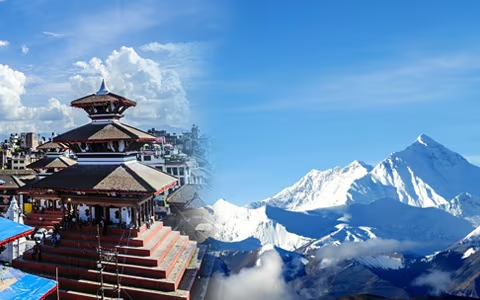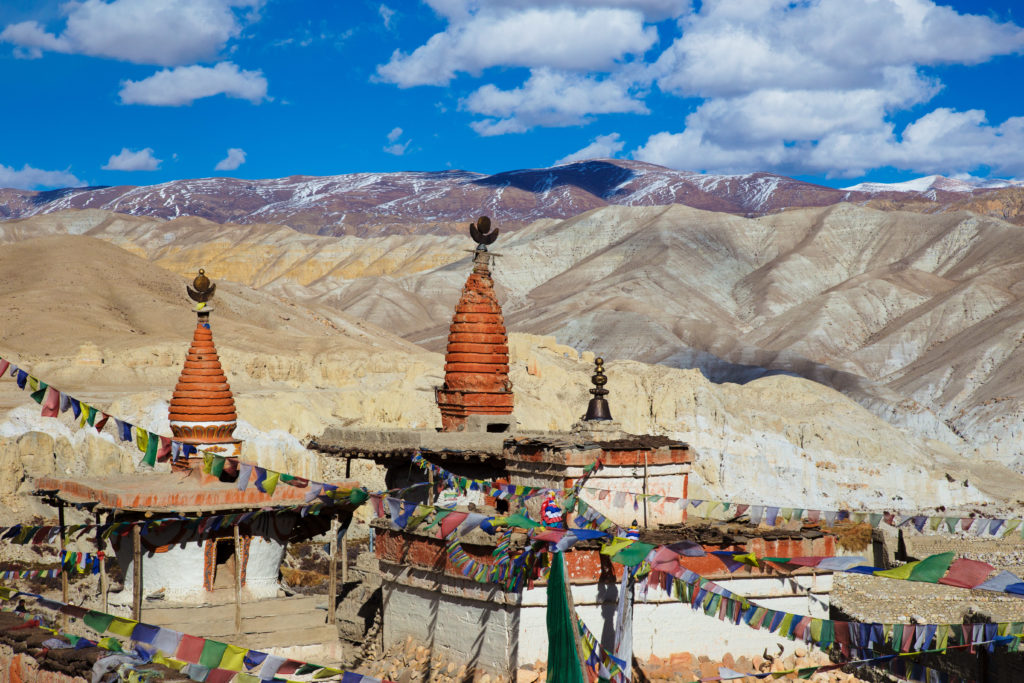Tibet
Most see places in Tibet.

Kathmand To Tibet Nepal to Tibet, a land popularly known as the ‘forbidden kingdom,’ a mystic Shangri-la up in the clouds, is now more accessible to tourists than ever. Easy flights from Kathmandu, Nepal, will promise you an unforgettable journey to this breathtaking region.
Here’s a rundown of some must-visit destinations in Tibet
Lhasa The spiritual heart of Tibet, where the magnificent Potala Palace and Jokhang Temple breathe life into ancient traditions and colorful culture.
Mount Everest Base Camp Awestruck by the foot of the world’s highest peak, witness the raw beauty of the Himalayas and the serenity of the Tibetan landscape.
Namtso Lake In Tibetan, it is referred to as Namco, meaning “Heavenly Lake.” Namtso is renowned for its turquoise-colored waters and beautiful mountains around; thus, this is a place of tranquility.
Gyantse Probably the most charming town in Tibet with a celebrated history, the main features are the Kumbum Stupa and the Gyantse Fortress.
The redHat sect has established the Tashilhunpo Monastery, which is the seat of Panchen Lama, and this city has given a most spiritual touch to the visitor.
Come join our highly experienced guides on an exploration into Tibet’s beauty and the enriched cultural heritage that awaits you. We’re here to help you have unforgettable moments in this land of magic!
Jokhang Temple (Tsuglakhang)
Jokhan in Lhasa TibetIf you see nothing else in Lhasa, visit the Jokhang Temple, the spiritual heart of Tibet. Built during the reign of King Songsten Gampo in the mid 7th century, and the scene of countless important events in Tibetan history, the Jokhang is surrounded by the Barkhor Square and prayer path, a circuit around the Jokhang that is constantly teeming with Tibetans and foreigners from all walks of life. You’ll find Tibetans prostrating at the temple entrance, and crowding the intensely beautiful chapels, all alive with the hum of prayers, clouds of incense and fantastic Buddhist paintings and statuary, including the Jowo Rinpoche, the most precious statue in Tibet, beautifully depicting the Buddha Shakyamuni at age 12.
Potala Palace
Potala Palace in Tibet Begun by the great fifth Dalai Lama and the winter home of all the Dalai Lama’s until the current 14th Dalai Lama fled Tibet in 1959, the Potala Palace is an architectural marvel, rising out of the center of Lhasa. But unlike the Jokhang, humming with prayers and life, the Potala is a dead shell of its former self, and can be a bit depressing to visit. It is literally now a museum instead of a living monastery and seat of government. While there is still a lot to see as you climb its thirteen stories (not recommended on your first day at altitude), it is absence that leaves the greatest impression — the absence of His Holiness the Dalai Lama, his monastery and Sho — the village at the foot of the hill. Still, it’s very worth a visit, and you if have some time in Lhasa, you will likely find yourself hanging out a bit, with a bunch of other Lhasa locals, on the Potang Shakor, the prayer circuit around the grounds of the Potala.
Nam-tso Lake
Nam-tso LakeOn a clear day, the beauty of the turquoise, salt waters of Namtso at the foot of the snow-peaked Nyenchen Tanglha range would take your breath away even if you weren’t at over 15,400 feet (4718 meters) when you arrive. You can get here in a long day trip from Lhasa, and take in the wide-open vista of water, sky and mountains with walks along the shore of the sacred lake. “Tso” means lake in Tibetan, so strictly speaking it’s repetitive to call it Nam-tso Lake. It’s not the greatest place to stay overnight, with really basic accommodation and an altitude high enough to feel the difference from Lhasa but if you do stay, you might be rewarded as we were with a gorgeous sunrise in crystalline high-mountain air.
Draksum-tso Lake (also called Basum-tso and Basong-tso)
Draksum-tsoA beautiful highland lake in Kongpo, the green waters of Draksum-tso are encircled by even higher peaks rising like walls out of the water. The lake is noted for the tiny, picturesque island at it’s center which is the home of several Nyingma nuns and their 14th century monastery, known as Tsodzong. The lake also has important spiritual and historical connections, both to Padmasambhava (Guru Rinpoche) and King Gesar. It takes about 7 hours from Lhasa to get there.
Drepung Monastery
Drepung MonasteryDrepung Monastery, founded in the 15th century, was for centuries one of the greatest monasteries of the world, home to several Dalai Lamas before the Great Fifth built the Potala, and housing up to 10,000 monks. Scattered over a hillside 8km outside of Lhasa, Drepung was perhaps the least damaged of Lhasa’s great monasteries by the Cultural Revolution, with many intact chapels and halls, though if you walk the kora around the perimeter, you will find large ruins partially hidden by the hillside vegetation.
Though a shadow of its former self, with only something like 500 tightly controlled monks in residence, Drepung still manages to retain some of its feeling of a living spiritual center. It is fascinating to wander the narrow lanes between the buildings, into chapels full of precious statuary, like the precious three-story high statue of Jampa, the future Buddha, portrayed at age 12.
If you are planning a trip to Tibet, we can put you in touch with a reliable Tibetan-owned agent who will plan a non-touristy trip that gives you a real feel for Tibet.
Samye Monastery
Getting to Samye, the first Buddhist monastery in Tibet, is a small adventure in itself. You can drive from Lhasa to the ferry crossing of the huge Tsangpo River, then catch an open-air truck for the bumpy ride to Samye. Or you can make the popular trek, taking in some spectacular views, from Ganden Monastery. Originally built in the 8th century, Samye is in a peaceful, pretty valley, its outer walls connecting to a village and barley fields that were beautiful to walk through at sunset. The entire monastery itself fascinatingly represents, like a mandala, the Tibetan Buddhist cosmos, with structures representing continents, the sun, moon and oceans around the central main temple, representing Mt. Meru, the legendary mountain at the center of the Buddhist world. And despite 1200 years of damage and restoration, Samye still holds an ancient and peaceful but living monastic presence in its mountain valley.
Lhodrak Sekhar Guthok
Sekhar-Guthok-Milarepas-TowerUsually a three-day round trip from Lhasa, near the Bhutanese border, Lhodrak district is the home of Milarepa’s Tower. (You can stop the first night in Nagartse on the quite beautiful drive, which goes by Sabolung Monastery and Yamdroktso lake.) Suggested by its name (“guthok”) to be nine stories, the unusual seven-story tower was built, according to Tibetan legend, by Marpa’s celebrated disciple Milarepa. Marpa put Milarepa through a hellish series of tests and humiliations to purify the disciple’s bad karma, including forcing him to build and rebuild various towers until accepting this, his fourth effort. The site, associated with the Kagyul School of Tibetan Buddhism, has a number of fine examples of wall-paintings from the 12th and 13th centuries, and may have the earliest image of Milarepa.
Sakya Monastery
Huge and foreboding, Sakya Monastery’s fortress-like outer walls are painted, very unusually, gray with red and white vertical stripes, instead of the usual Tibetan whitewash. Until 1959 the home of His Holiness Sakya Trizin, head of the Sakya sect of Tibetan Buddhism, the monastery has two parts, split by the Trum-chu river. The older, northern side, in ruins on the hill, is good for hiking and views of the massive newer (13th c) buildings across the river. The southern buildings, which have been undergoing substantial renovations, contain thousands of sacred artworks, scriptures and artifacts, including a conch shell used to summon the Buddha Sakyamuni’s disciples to teachings. You can include a visit to Sakya on the way to Everest Base Camp from Lhasa, or take a bus 127km from Shigatse.
Everest Base Camp
Mount Kailash (Kang Rinpoche — Precious Jewel of Snow)
Mt. Kailash
Mount Kailash, known as Kang Rinpoche (Precious Jewel of Snow), is the source of four great Asian rivers and sacred to Hindu, Buddhist, Jain, and Bon faiths. Pilgrims undertake a 3–4 day kora (circumambulation) around its 52 km base, starting at 4,600m and crossing a 5,600m pass. Visiting usually takes 15–23 days overland from Lhasa, and requires good fitness and preparation.



